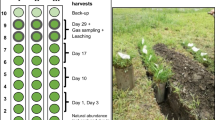Abstract
Carbon sequestration in 30 yr old Norway spruce in south Sweden following manipulation of nutrient and water availability is presented. The site has an annual precipitation of 1100 mm and a deposition of about 20 kg N and 25 kg S per ha−1 yr−1. The soil type is a poorly developed podzol. Treatment include irrigation; artificial drought; ammonium sulphate addition; nitrogen-free-fertilization and irrigation with liquid fertilizers including a complete set of nutrients. The experiment has a randomized block design with four replicates per treatment. A comprehensive investigation of the above ground C storage on an areal basis was made at the start of the experiment and after 3 yr of treatment. After 3 yr of treatment with simulated N-S deposition using ammonium sulphate (100 kg N, 114 kg S ha−1 yr−1), C accumulation rates in the above ground compartments had increased by 37%. Similarly, irrigation caused increased C accumulation rates by 25%, whereas simulated drought during the vegetation period during 2 yr followed by 1 yr of recovery caused a 15% reduction of the C accumulation rates. Irrigation combined with liquid fertilization (100 kg N ha−1 yr−1), including all important nutrient elements, led to 65% increase in C accumulation rates compared to the control. The C sequestration of the latter treatment gradually increased and, during yr 5 of treatment, 8.6 Mg C ha−1 accumulated in stems and branches, compared to 3.6 Mg ha−1 for the control. It is concluded that there is a strong interaction between N-deposition and C accumulation rates in Norway spruce in south Sweden. The C accumulation rates are also sensitive to water availability. The study indicates a great potential to cultivate Norway spruce in south Sweden as a renewable energy source. A shift in energy source from fossil fuels to renewable energy sources will directly reduce the net emissions of CO2 to the atmosphere.
Similar content being viewed by others
References
Berg, B. and Ekbohm, G.: 1991,Can. J. Bot. 69, 1449.
Detwiler, R.P. and Hall, C.A.S.: 1988,Science. 239, 42.
Eriksson, H. and Johansson, U.: 1993, Yield of Norway spruce (Picea abies (L.) Karst.) in two consecutive rotations in south-western Sweden.Plant and Soil. (accepted).
Ingestad, T.: 1979,Physiol. Plant. 45, 373.
IPCC (International Panel on Climate Change), 1992. IPCC 1992 Science Assessment. Report to IPCC from Working Group 1, prepared by the IPCC Group at the meteorological Office, Bracknell, UK.
Johnson, D.E.: 1992,Water, Air, and Soil Pollution. 64, 83.
Johnson, D.W., Cresser, M.S., Nilsson, S.I., Turner, J., Ulrich, B., Binkley, D. and Cole, D.W.: 1991, Soil changes in forest ecosystems: evidence for and probable causes. International Conference on Acid Deposition. Its Nature and Impacts, Glasgow, 1990, Proceedings of the Royal Society of Edinburgh, 97B, pp. 81–116.
Kauppi, P. Mielikäinen, K., Kuusela, K.: 1992,Science. 26, 70.
Kenk, G.:1990, Effects of air pollution on forest growth in south-western Germany — hunting for a phantom? Proc. Div. 2 XIX IUFRO World Congress, Montreal, Canada.
Linder, S.: 1992, private communication.
Marklund, L.G.: 1987, Biomass functions for Norway spruce (Picea abies (L.) Karst) in Sweden. Dept. For. Survey, Swed. Univ. Agric. Sci., Rep. 43, 127 pp.
Möller, G.: 1986, Results from forest fertilization trials in areas with high nitrogen input, inNitrogen saturation, abstracts from a workshop. National Swedish Environmental Protection Board. Report 3153, pp 49–61.
Nilsson, L.O. and Wiklund, K.: 1992,Plant and Soil. 147, 251.
Nohrstedt, H.-Ö., Arnebrant, E. Bååth, E. and Söderström, B.: 1989,Can. J. For. Res. 19, 323.
Persson, T.: 1993, private communication.
SAS Institute Inc. 1989 SAS/STAT User's Guide: Basics, Version 6, Fourth Edition, Volume 2, Cary. NC:SAS Institute INC. 846 p.
Tans, P.P., Fung, I.Y. and Takashi, T.: 1990,Science. 247, 1431.
Whittaker, R.H. and Marks, P.L.: 1975, Methods of assessing terrestrial productivity, in: Lieth H. and Whittaker R.H. (eds)Primary Productivity of the Biosphere, Springer-Verlag, New York Inc, pp 55–118.
Wisniewski, J. and Lugo, A.E.: 1992a, Workshop Statement. Natural sinks of CO2. Palmas Del Mar, Puerto Rico, 24–27 February 1992, Kluwer Academic Publishers, 6 pp.
Wisniewski, J. and Lugo, A.E.: 1992b, Natural sinks of CO2. Palmas Del Mar, Puerto Rico, 24–27 February 1992, Kluwer Academic Publishers, 466 pp.
Author information
Authors and Affiliations
Rights and permissions
About this article
Cite this article
Nilsson, L.O. Carbon sequestration in Norway spruce in south Sweden as influenced by air pollution, water availability, and fertilization. Water Air Soil Pollut 70, 177–186 (1993). https://doi.org/10.1007/BF01104995
Received:
Revised:
Issue Date:
DOI: https://doi.org/10.1007/BF01104995




